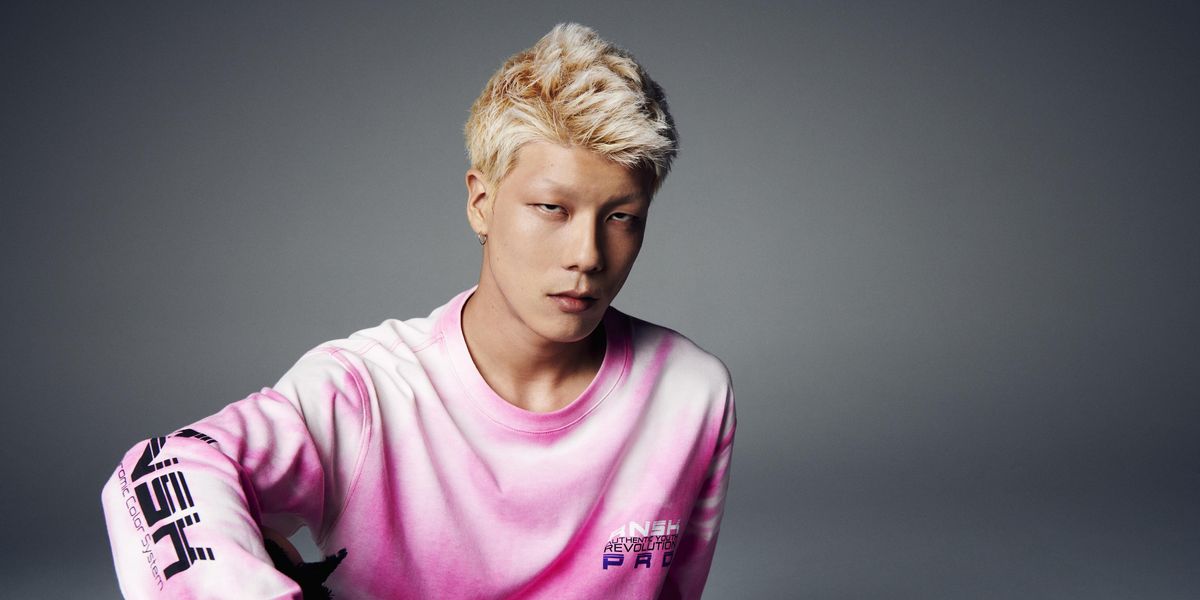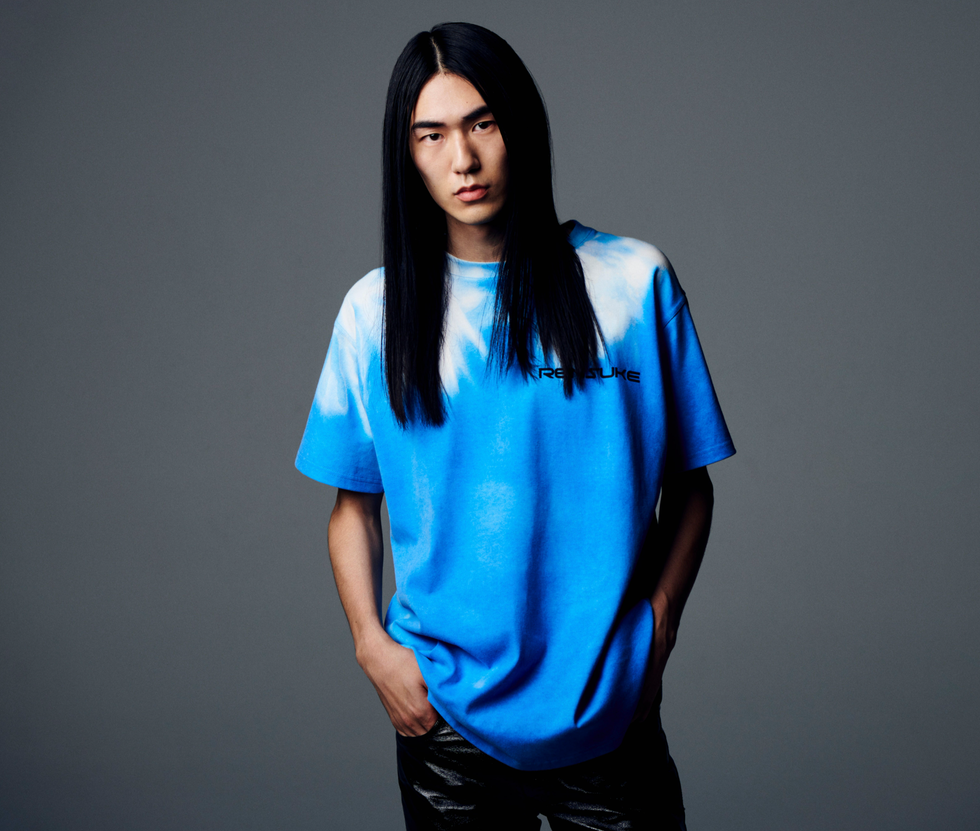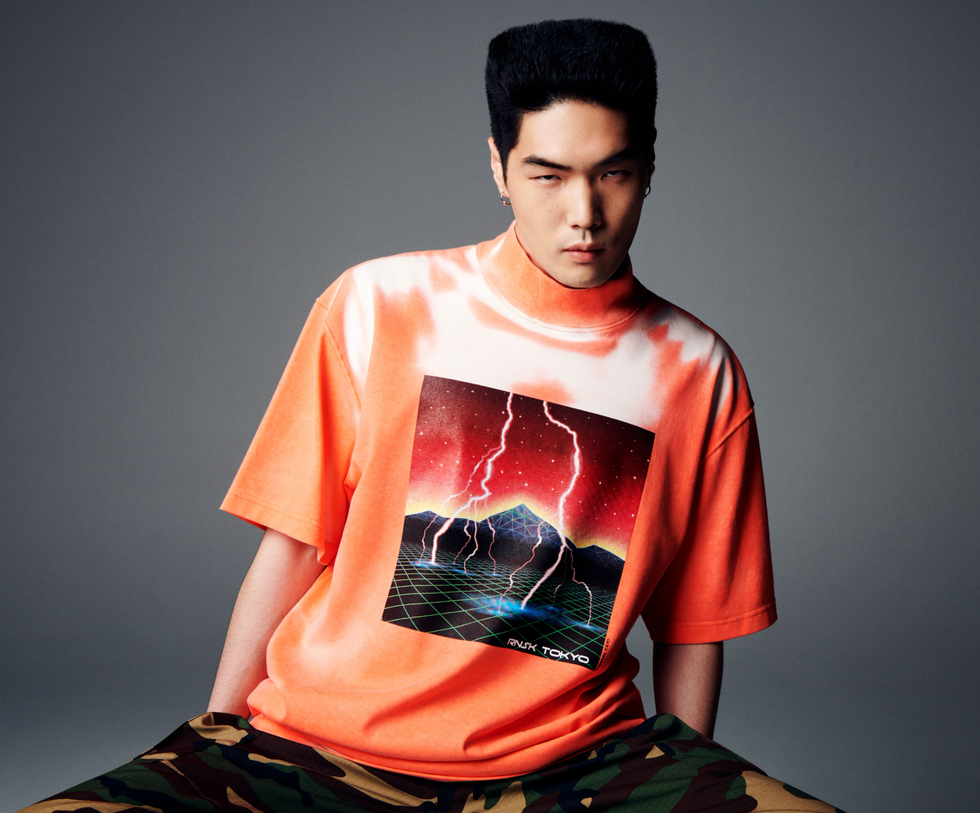
Fashion might be slow to adopt advances in wearable tech on a wide scale, but a new streetwear label from Japan seems poised to make breakthroughs in technology more accessible for the everyday wardrobe.
Rensuke Tokyo spent three years working on a formula for clothes that react to body heat. The brand recently launched with a collection of bright t-shirts and sweatshirts that change color when the wearer's body temperate reaches 71 degrees Fahrenheit, becoming completely transparent when it reaches 88 degrees.
The thermochromic treatment was first invented in Japan in 1989 but Rensuke Tokyo says its the first fashion brand to handprint this type of technology, and all of the clothes are hand-made, embroidered, and printed in small batches by Japanese artisans in Kyoto.
Once exposed to body heat, the fabric quickly changes hues to create unique patterns and effects, and these areas get lighter depending on the time worn, with all effects being temporary. Founder Katsu Nakamura walked us through the technology behind his brand and how it all came together.

What was your background before launching RENSUKE Tokyo?
I grew up in Tokyo during the time Japan became famous for its various street fashion 'tribes'. Japanese people, while tied to traditions and conservative in some ways, are extremely open minded when it comes to fashion and experimenting with mixing items from different cultures to create their own subcultures. I was lucky enough to grow up in Japan during this time and I felt that excitement and importance around creating personal style and making your look 'your own'.
So, I always look back at that as something that inspired me. Before starting to experiment with thermochromic paints and dyes, both as an artist and as a fashion designer, I trained as a hairstylist and worked with celebrities in Tokyo and New York City.
Can you walk me through the color-changing formula used?
The first ever color-change thermochromic inks were invented in a small town near Tokyo in 1989. When I started creating my art some years ago, I was already dreaming of experimenting with this kind of retro futuristic color changing ink. I visited the inventor of this original formula to learn more. When I decided to incorporate heat-sensitive color changing ink colors into my interactive art as well as to produce a couture streetwear collection with a unique color change technology, I worked with him to create a custom formula which reacts to body heat at a specific temperature setting.
RENSUKE TOKYO thermochromic fabrics start to change at 71 degrees and become completely transparent (white) at 88 degrees. It's pretty cool to see someone's reaction the first time they see the color changing. 100% of people smile and say "wow-oh my God!"
How did you redevelop this technology, and how did it become integral to the brand?
It was very important to me to create a product that offers excitement to the wearer. Especially when it comes to streetwear, often streetwear brands produce their products by mass production in countries that utilize poor working conditions. Japan is the opposite of this - our workers are lifelong experts in all types of unique dye techniques and fabric manipulation. Our planning office is located in Harajuku and our garments are produced by hand. Products are hand-embroidered; colors are hand printed, all work done meticulously in Kyoto.
To redevelop this thermochromic technology, I wanted to make a stronger product than the ones I had seen in the past. That is why our colors are hand printed instead of dip dyed. It makes our color very strong. It also allows for the color to reset very well, for example when you are walking in the street and then suddenly enter an air-conditioned building, the color returns beautifully like magic. Regarding the ingredients, we worked for 3 years on the color temperature setting to make a formula that is completely hypoallergenic. We tested it in Japan, and it is safe for newborn babies' skin.

What inspired this collection?
I was a kid in the 80s and 90s in Japan so I get excited by anything retro-futuristic. Clothing wise I was inspired by 80s surfer boys' shirts from brands like Ocean Pacific or Quicksilver as my first point of reference when thinking about the feeling I wanted. I wanted something that felt retro but then again at the same time futuristic, maybe years in the 2190s. I am inspired by Japanese street culture in the 90s. In Tokyo teenagers would dress up according to their tribes.
I was always inspired by bright colors, Japanese surf style, hip-hop, and skateboarders are big influences for me, especially our long sleeve t-shirt I made specifically inspired by the kinds of shirts skateboarders like Olympic gold medalist skateboarder Yuto Horigomo and other icons wear. I also get inspired by the outfits of basketball players style like Kyle Kuzma and Jordan Clarkson, as well as k-pop stars like NCT127, Straykids and Dawn.
Can you tell me about the graphics on some of the sweatshirts and tees in this collection? What does the imagery of a lightning strike signify?
I saw an image I had kept on my phone for a few years of Sakurajima Volcano in Japan exploding with lava and being struck by lightning at the same time. I thought, this is the feeling I want to see when my shirts change color.
What’s next for RENSUKE Tokyo?
I have been working on my thermochromic heat-sensitive interactive art for the past years and hope to display in a cool way in the near future possibly along with my ready-to-wear. As I meet inspiring people, I will collaborate using my technology to offer a unique never before seen product in various categories.
Photos courtesy of Rensuke Tokyo
Related Articles Around the Web